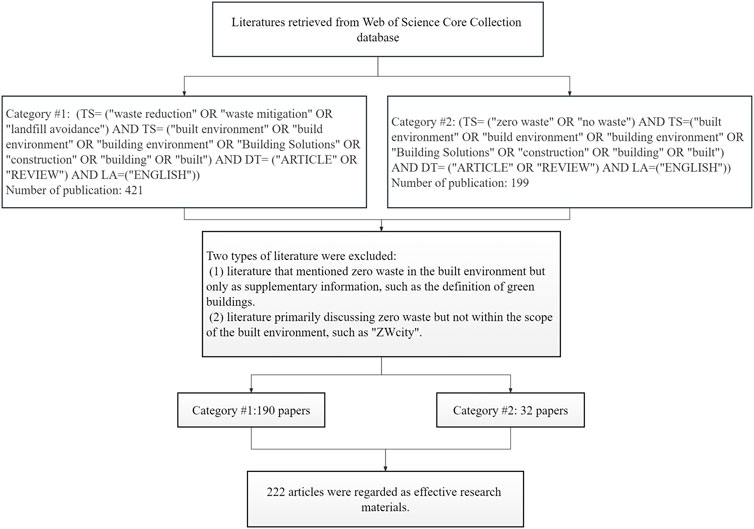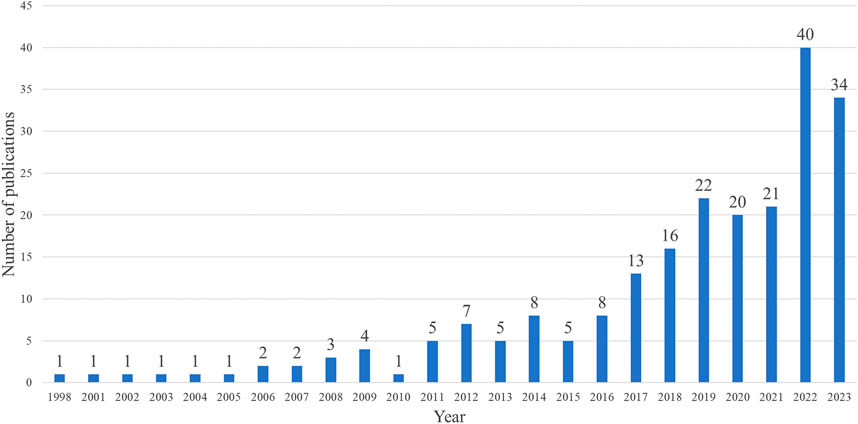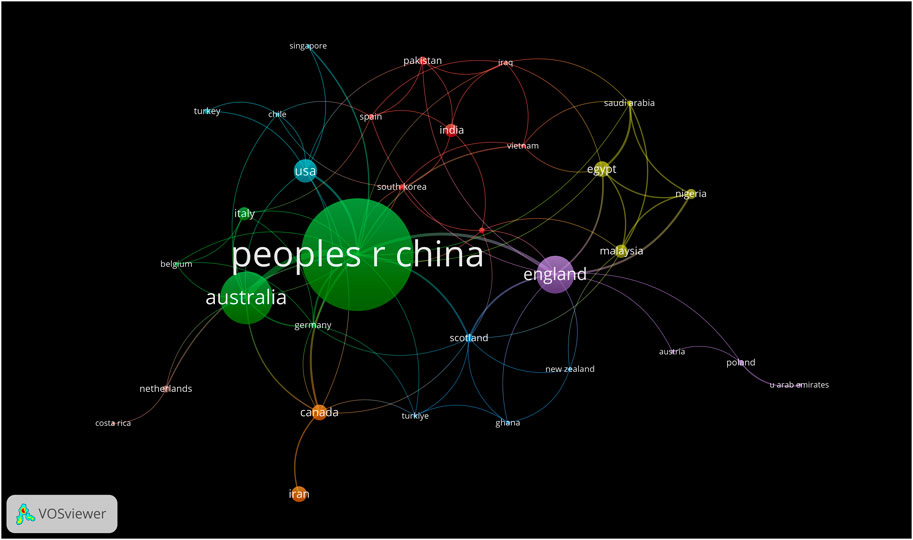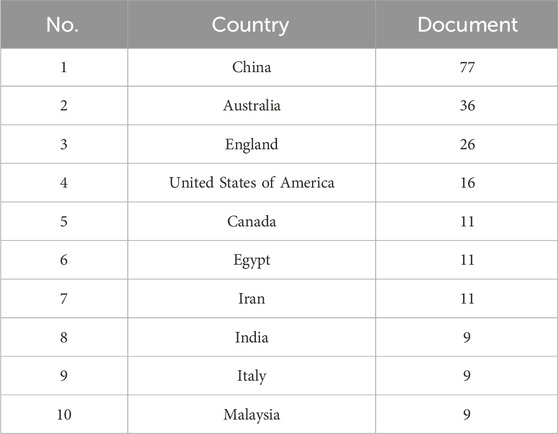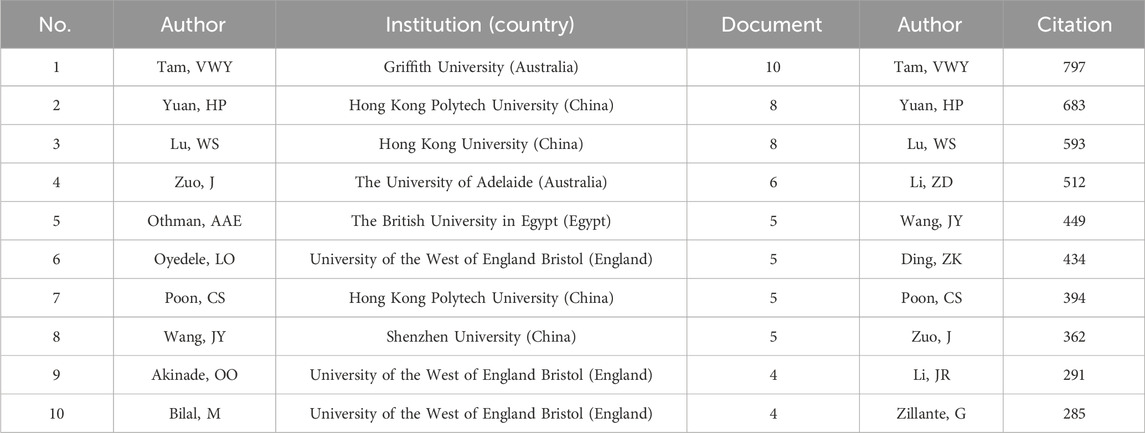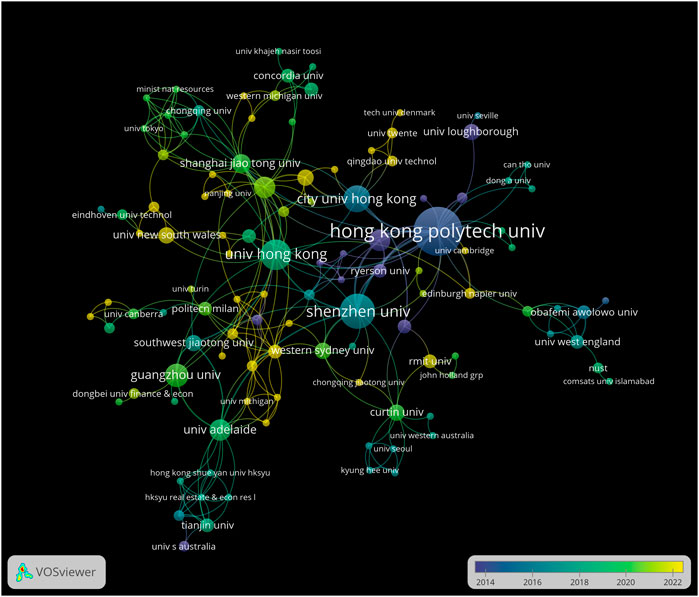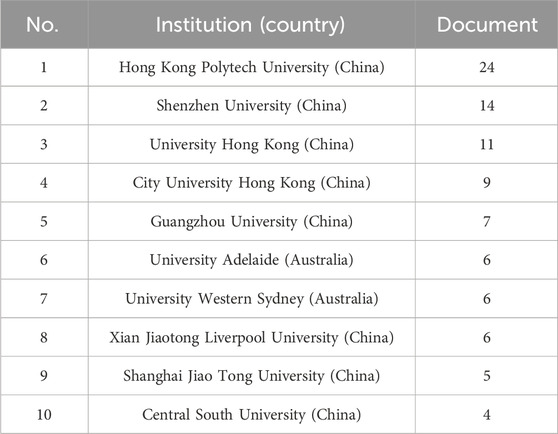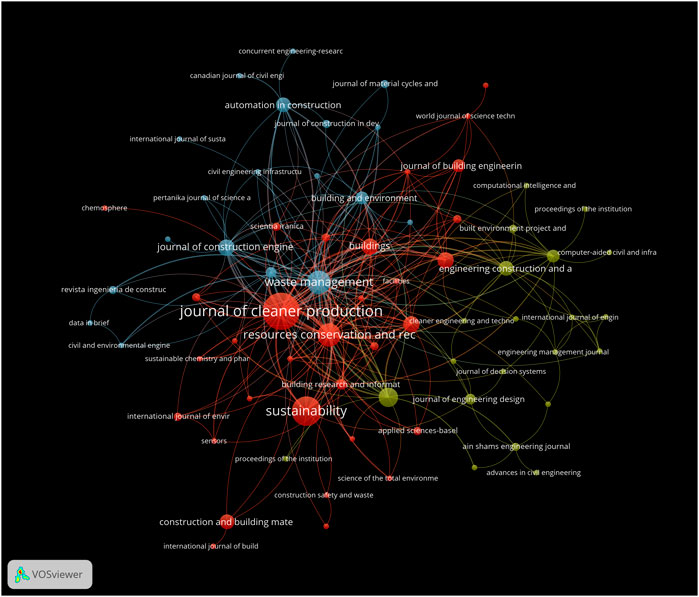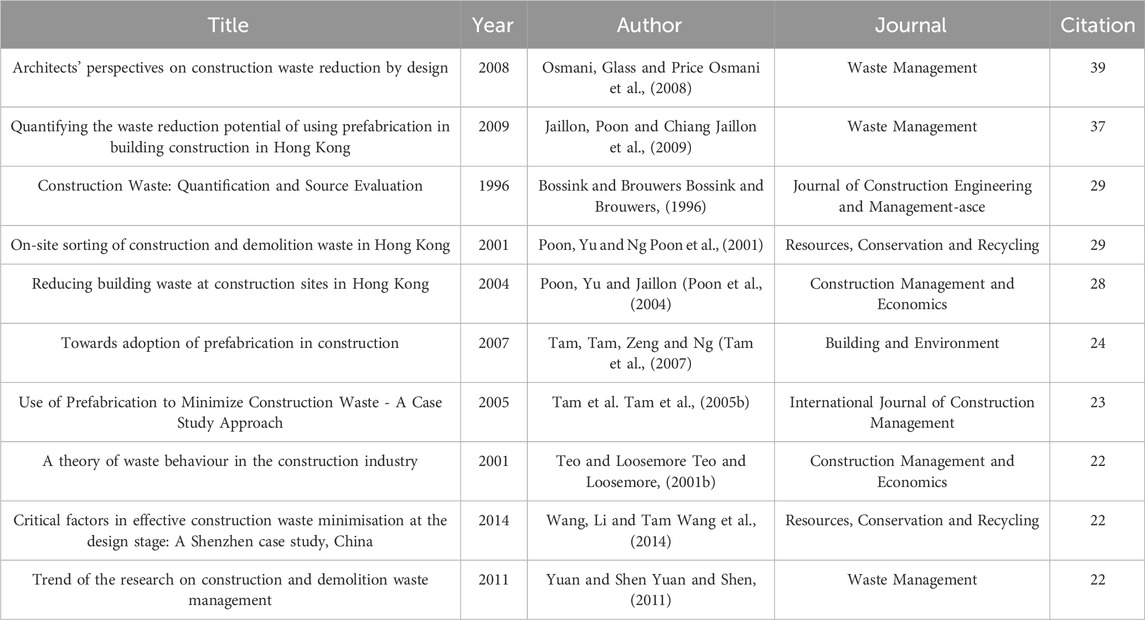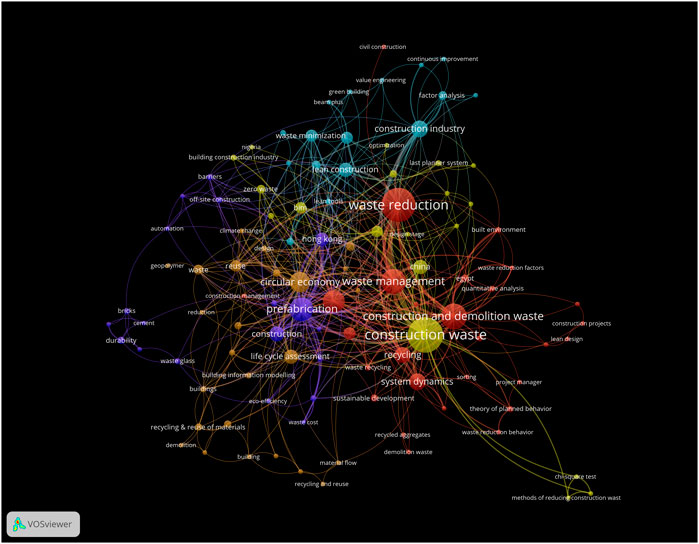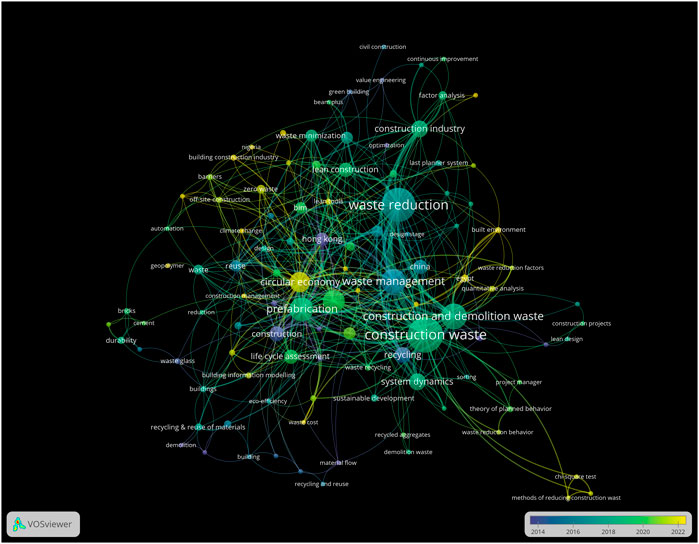- Academy of Fine Arts, Nanjing Normal University, Nanjing, Jiangsu, China
The global construction industry presents a significant challenge to environmental sustainability, sparking increasing concerns regarding its environmental impact. Zero Waste (ZW) has become a comprehensive waste management approach within the construction sector. However, there is a notable absence of systematic reviews in this field. Bibliometrics has played a pivotal role in advancing new methodologies for systematic reviews. To address this gap, our study employs VOSviewer to systematically review the research domain of ZW, exploring research trends, international collaborations, primary authors, research domains, and literature. Our findings reveal a pronounced upward trend in research dedicated to achieving zero waste goals in the built environment, aligning with escalating global environmental concerns. Research in this realm has thrived notably in China, Australia, and England, with these countries contributing significantly to relevant studies. Co-occurrence analysis highlights key themes, such as construction waste reduction, sustainable construction, circular design, prefabrication, and Building Information Modelling (BIM). Notably, system dynamics and BIM have emerged as crucial modelling techniques. Moreover, this study emphasises the adoption of circular economy principles, the efficacy of prefabrication, and the role of BIM in waste management. Future research directions encompass exploring global variations, investigating the impact of technology, engaging stakeholders, and considering regulatory frameworks. Despite its limitations, this study underscores the mounting global interest in ZW research, providing a foundation for future exploration and collaboration in sustainable construction and environmental management.
1 Introduction
The construction industry poses substantial challenges to global environmental sustainability (Faleschini et al., 2016). While playing a pivotal role in the global economy and social development (Vitale et al., 2017), it raises concerns due to its ecological impact. This industry not only consumes extensive natural resources but also contributes to 40% of global resource depletion, 18% of greenhouse gas emissions, and 25% of waste generation (Teh et al., 2018). Additionally, the construction industry accounts for over 35% of global energy-related greenhouse gas emissions and consumes half of the world’s raw materials (Jayasinghe and Waldmann, 2020). Consequently, there is a growing focus on the environmental sustainability of the construction industry (Hossain and Poon, 2018).
The construction industry is both a high carbon-emitting industry and a substantial consumer of materials and energy (Sisson, 2020). Construction and demolition (C&D) activities generate one-third of global waste production (Wilson et al., 2015). The prevailing notion in the global construction sector is bib_defra_2022that construction activities, whether new construction, renovation, or demolition, invariably result in a certain degree of resource wastage (Teo and Loosemore, 2001a; Lu et al., 2017). Numerous studies have been conducted to quantify construction waste generation using various methods, including on-site observations, waste generation rates, lifecycle analysis, classification system accumulations, and variable modelling (Wu et al., 2014). Additionally, environmental agencies and government departments release annual construction waste statistics [e.g. (Eurostat, 2023; HKEPD, 2022; EPA; DEFRA, 2022)], demonstrating that construction waste makes up as much as 25% of solid waste sent to landfills (Lu et al., 2019). For instance, in Australia, in the 2021–2022 fiscal year, approximately 29 million metric tons of construction and demolition waste were generated, accounting for 38% of total solid waste generation (Pickin et al., 2023). About 64,000 metric tons of this waste were improperly disposed of in landfills despite their high potential for reusability (Pickin et al., 2023).
In recent years, ZW has emerged as an approach to promoting sustainability in the construction industry. This ideology emphasises waste prevention, resource redesign, and reuse to minimise waste generation, transforming waste into resources and reducing reliance on natural resources to the greatest extent (Murphy and Pincetl, 2013). The definition of ZW underscores the design and management of products and processes to systematically reduce the volume and toxicity of waste and maximise the protection and recovery of all resources, avoiding incineration or landfilling (Alliance, 2022). This concept encourages a shift from linear resource use and disposal patterns to closed or circular material flows, viewing waste as potential resources rather than problems. It promotes a circular economy through principles like reduce, reuse, recycle, recover, and residual disposal (Lee et al., 2020; Gaur et al., 2022), offering multiple advantages such as cost reduction, profit increase, and reduced environmental impact (Elgizawy et al., 2016a).
Considering waste as a resource is a key strategy in circular economy (CE) modelling, focusing on recovery and recycling to reduce raw material costs and improve resource efficiency and environmental benefits (Ayçin and Kayapinar Kaya, 2021). The core objective of CE is to achieve zero waste management, wherein zero waste generates economic value through material savings, waste remarketing, waste reuse, and the prevention of environmental damage (Nizar et al., 2019). Recycling and reuse of waste are prerequisites for a circular economy, which can lead to efficient use of resources and materials by reducing production costs, creating jobs, and establishing linkages (Deselnicu et al., 2018). Waste management has become a prominent issue within the CE, especially for municipalities, public institutions, managers, and researchers. However, implementation studies on this issue are relatively new and insufficient (Zhang et al., 2019). In 2015, the European Commission adopted the Circular Economy Package, which includes proposals for the regulation of legislation and an integrated action plan for waste. To promote economic growth and guard against environmental catastrophes, the Zero Waste Programme takes preventive measures, such as the application of eco-design principles in product design, waste reduction and recycling, and the reduction of greenhouse gas emissions (VERAL et al., 2018). The implementation of the zero-waste strategy is expected to create significant value for the circular economy by reducing the cost of raw materials and utilizing limited resources more efficiently (Indicators, 2016). Related research has explored the scope and types of waste under ZW management (Zaman, 2015), the concept and its benefits, challenges, and critical factors (Pietzsch et al., 2017), the application of ZW technologies in waste management systems (Singh et al., 2017), technological challenges in the ZW manufacturing value chain (Kerdlap et al., 2019), specific ZW initiatives in various sectors (Phillips et al., 2011) international waste management schemes (Xevgenos et al., 2015), and the latest technologies in achieving ZW goals in particular industries (Stanescu, 2021). ZW research is interdisciplinary, encompassing clean production, green consumption, and industrial ecology. The concept of ZW goes beyond waste management methods and includes related technologies and empirical research on its global, especially recent, implementation.
Adhering to the Zero Waste (ZW) concept represents a crucial stride toward sustainable development in managing construction and demolition waste. The primary objective is to minimize waste generation to the utmost extent, converting waste into valuable resources. This approach effectively mitigates the adverse environmental impacts associated with landfill sites, concurrently fostering the maximization of resource utilization within industrial and construction processes. It also involves modifying resources to better align with the needs of other industries or functions (Elgizawy et al., 2016a; Elgizawy et al., 2016b). From an environmental perspective, ZW strategies play a pivotal role in reducing public health risks and greenhouse gas emissions linked to landfill sites, concurrently diminishing energy consumption in production. This not only contributes to environmental preservation but also creates opportunities for economic and societal growth through resource recovery (Nordahl et al., 2020; Ahmed et al., 2023).
Recently, the ZW concept has been evolving and gradually becoming a concrete plan implemented globally. However, systematic review studies on ZW in construction remain relatively scarce and lack visual representation. This paper aims to use scientometric analysis methods to visually depict existing publications related to ZW in the construction environment, offering a clear framework of academic research on the concept in the construction field and providing information about the characteristics and trends of related publications. This review provides an in-depth analysis of the global importance of the ZW goal in the field of built environment and provides researchers and practitioners with effective strategies to achieve the ZW goal. Meanwhile, by analysing the research trends, keywords and collaborative networks, this paper explores the future directions of the ZW research in the built environment and helps researchers explore cutting-edge issues. The paper also identifies the prominence of different countries in zero-waste research and promotes in-depth collaboration and knowledge sharing among international researchers. The results of this study will fill knowledge gaps and offer valuable insights for decision-makers and researchers.
2 Data sources and methods
2.1 Defining the research scope
The initial consideration in bibliometric analysis is determining the scope of the study. It is crucial to clearly define the content and quantity of research to be investigated before commencing the study. Without a well-defined scope, the results may be poor, riddled with errors, and not align with the primary research objectives. Therefore, thoroughly evaluating the keywords used in data collection is essential. Concerning the investigation of ZW, the following aspects were considered:
• Core Concept and Objectives of ZW: Waste is considered a potentially valuable resource in zero waste. Its primary objective is to reduce waste generation, mitigate waste management risks, and strive for minimal or near-zero waste disposal, including reducing landfilling, incineration, and untreated waste.
• Methodology of ZW: Zero waste aims to transition from a linear system to a circular or closed-loop system through systematic and goal-oriented waste management. This methodology encompasses waste management and the eco-design of products and technologies to reduce waste generation throughout the entire supply chain, ultimately reducing the extent of waste sent to landfills and incineration. Related strategies include sustainable industrial design, raising public awareness through education and research, promoting sustainable consumption and behaviour patterns, and formulating relevant laws and policies (Zaman and Lehmann, 2013).
2.2 Collecting bibliometric data
In this study, the first step involved selecting relevant journal articles from the Web of Science (WoS) database to create a comprehensive analysis database. Although WoS and Scopus are considered comprehensive data sources for various purposes (Zhu and Liu, 2020), WoS supports a wider range of citation analyses than the Scopus database (Falagas et al., 2008). WoS is the first international bibliographic database with a wide range of bibliographic data, and it is the most influential data source for authoritative tasks such as journal selection, research evaluation, and bibliometric analysis (Li et al., 2018; Birkle et al., 2020a). Although Google Scholar provides free access to scholarly literature in all genres, languages, and fields, it was not considered due to the sporadic coverage of non-English literature, data inconsistencies, and lack of transparency in reporting. The search was refined by creating search strings to ensure scientific rigour (Birkle et al., 2020b).
The second stage entailed retrieving database records. Academic database search criteria were employed to select papers on the relevant subject from journals. Data were collected from WoS by introducing the following terms in the topic (TS) search field. This selection procedure followed the latest developments in using search strategies with search strings (Ng et al., 2022). The literature search was based on the clearly defined scope mentioned before, including “zero waste”, “landfill avoidance” and related terms, which were selected based on their relevance to the research area. These terms were considered as the basis for a set of publications on zero waste in the built environment. In addition, synonyms or modules such as “waste reduction” and “waste mitigation”, “zero waste” or “no waste” were considered, as well as qualifiers for the research area, such as “construction” OR “building” OR “built”. Finally, we employed two sets of terms:
• Category #1 included all components related to ZW in the built environment, such as “waste reduction”, “waste mitigation”, and “landfill avoidance”. Therefore, the search string for Category #1 was [TS = (“waste reduction” OR “waste mitigation” OR “landfill avoidance”) AND TS = (“built environment” OR “build environment” OR “building environment” OR “Building Solutions” OR “construction” OR “building” OR “built”) AND DT = (“ARTICLE” OR “REVIEW”) AND LA=(“ENGLISH")].
• Category #2 included “zero waste”, and “no waste” and their abbreviations. The search string for Category #2 was (TS = (“zero waste” OR “no waste”) AND TS = (“built environment” OR “build environment” OR “building environment” OR “Building Solutions” OR “construction” OR “building” OR “built”) AND DT = (“ARTICLE” OR “REVIEW”) AND LA=(“ENGLISH")).
Articles and reviews are typically considered more significant scientific contributions than conference proceedings and book reviews (Su et al., 2019), and the study assessed all time frames. Figure 1 shows the entire retrieval process.
The third stage was literature selection. First, redundant literature was excluded, and its compliance with inclusion criteria was verified. Subsequently, each article’s core content was thoroughly read and analysed to determine its relevance to zero waste in the built environment. Two types of literature were excluded: 1) literature that mentioned zero waste in the built environment but only as supplementary information, such as the definition of green buildings, and 2) literature primarily discussing zero waste but not within the scope of the built environment, such as “ZW city”. Ultimately, 222 peer-reviewed articles were selected for subsequent bibliometric analysis.
2.3 Analyzing data using bibliometric analysis methods
Bibliometric analysis, a quantitative method for analysing academic literature using citation data, provides descriptions, evaluations, and monitoring of published research (Garfield et al., 1964). This method is used to examine trends in ZW fields. Bibliometric methods aim to analyse publications, citations, and information sources.
Each bibliometric method is useful for specific research questions, with scientific mapping used to answer the most common questions using bibliometrics (Aria and Cuccurullo, 2017). To achieve our objectives, we selected the most suitable bibliometric analysis methods and techniques described by Donthu et al. (Donthu et al., 2021). Bibliometric analysis is used to detect evolving research trends in specific fields and pinpoint emerging topics shaping the advancement of knowledge in that field. Finally, we chose VOSviewer as the primary analysis tool because it utilises advanced algorithms and computational logic, making it well-suited for processing and visualising extensive datasets, ensuring high-quality visualisations (Van Eck and Waltman, 2010).
3 Results
3.1 Publication performance analysis
The number of publications provides a concise overview of the current state of evolution within the field (Geng et al., 2022). Figure 2 shows the evolution of the number of publications on ZW in the built environment from 1998 to 2023. Overall, there is a gradual increase in the publication trend. Specifically, between 1998 and 2010, the published literature remained relatively stable, with a low number of publications, typically no more than five articles per year. Despite being relatively under-researched, this phase laid the foundation for understanding the concept of ZW and exploring research methodologies. From 2011 to 2016, the literature experienced a faster growth trend, although the number of publications remained relatively low, consistently ranging from five to ten papers per year. Starting in 2017, the number of relevant publications consistently exceeded ten papers annually, reaching its peak in 2022 (data for 2023 is incomplete). Notably, both 2022 and 2023 exhibited a significant increase compared to previous years, indicating an elevated recognition of the importance of ZW in the built environment over time. This trend suggests that research in this field will continue to flourish, attracting more scholars who will collectively contribute to the coordinated development of the environment, society, and economy.
3.2 Major countries or regions involved in the research
ZW in the built environment and related research exhibits distinct characteristics in different countries and regions (Zhang et al., 2022). Examining the publication locations can reveal the disciplinary standing, international cooperation, and exchange in research topics (Alnajem et al., 2021). Figure 3 showcases the countries with the highest number of publications on ZW in the built environment, based on the results of bibliometric analyses. Only countries with a minimum of two publications are included in the figure. The visualization indicates that China has the highest number of publications and exhibits a strong connection with Australia and England, highlighting the substantial link between China and these two countries.
From the Table 1, China stands out as the country with the most publications, contributing 77 articles on ZW in the built environment. Australia and England follow closely with 36 and 26 relevant journals, respectively. The United States comes next with 16 articles, followed by Canada, Egypt, and Iran, each contributing 11 articles. Finally, India, Italy, and Malaysia each have nine articles. The figure also illustrates that China, Australia, England, and Egypt are near, indicating active research collaboration among them, particularly between China and Australia, as evidenced by the thicker connecting line. These findings point to several key observations:
Both developed and developing countries strive to achieve ZW goals in the built environment, with a particular emphasis on China, Australia, the UK, and the United States, where research in this field is prominent. For instance, the United States generates approximately 600 million tons of C&D waste annually (EPA. Construction), the EU produces over 800 million tons annually (Pickin et al., 2020), and China contributes about 3 billion tons annually (Hao et al., 2020). Achieving ZW in the built environment has become critical due to its adverse environmental, economic, and social impacts. Since these countries face similar challenges in the built environment, their research holds significant implications for practice and policy.
Countries like China, Australia, England, and the United States possess abundant research resources and expertise covering urban planning, economics, construction technology, geography, and related areas. This research has received academic support and specialised knowledge.
The figure demonstrates that countries such as China, Australia, England, the US, and Canada exhibit high international research collaboration and academic exchange levels. Their researchers actively participate in international conferences, collaborative projects, and knowledge exchange, fostering cross-border cooperation and disseminating research outcomes. Regional collaboration is notably closer, particularly between China, Australia, and the United Kingdom.
While some countries like China, Australia, and England have a significant concentration of research on ZW in the built environment, it is essential to acknowledge that ZW is a global issue, and different countries and regions may face varying challenges and research needs. Therefore, cross-national collaboration and knowledge sharing remain crucial in achieving ZW goals in the built environment.
3.3 Key productive authors
The relationships among articles and scientific cooperation among authors are essential components of co-authorship analysis (Chen, 1999). In this research field, 726 authors have contributed to the work. Table 2 lists the top 10 most active authors in this field. The data reveals that these top 10 authors have published 60 articles over the entire research period. Leading the list, Tam, VWY from Griffith University, has published 10 papers, totalling 797 and an impressive average citation rate of 79.7% per article. Following closely, Lu, WS, from Hong Kong University and Yuan, HP, from the Hong Kong Polytechnic University have published 8 papers each. As of 2023, Lu, WS, has been cited 593 times, and Yuan, HP, has been cited 683 times. It is important to note that the citation count does not always directly correlate with the number of articles published. Only the top three authors have citation counts that align with their article output, suggesting that they are the most influential in the field and warrant attention. Furthermore, these top ten authors all hail from countries within the top ten rankings, indicating that the geographical location of the universities also plays a role in the research productivity of authors.
3.4 Distribution characteristics of research institutions
Research institutions play a pivotal role as physical entities in relevant research fields. Understanding the distribution characteristics of these institutions helps gain a clearer perspective of the significant contributors to research on ZW in the built environment. The visual overlay of research institutions in Figure 4 provides insight into the status of 326 research institutions. In this graph, the size of each node represents the number of research articles published by the institution, the lines connecting nodes indicate collaboration between institutions, and it also reveals the temporal development trends of these institutions. Institutions marked in deep blue and purple have an average publication year traceable back to 2014 or earlier, while the most recent research is denoted by light green and bright yellow. Among the top ten research institutions (Table 3), eight are located in China, and three are in Australia, reflecting the research strength of these two countries in this field, consistent with their national distribution characteristics. Of particular note, the University Western Sydney, Griffith University, and Loughborough University appear dimly in the graph, indicating that their research output is primarily concentrated in or before 2014. This suggests that these institutions have been early adopters in this research field, establishing foundational research outcomes and providing necessary initial support for ongoing research.
3.5 Citation analysis of journals
Figure 5 provides a visual representation of the citation relationships to summarise the distribution of the early knowledge base in the field of ZW in the built environment and the disciplinary support. This helps refine the disciplinary system and knowledge framework, making it easier to analyse the field’s most significant and active research sources (Liu et al., 2023). Based on the results in VOSviewer, 97 source journals were identified. The network diagram represents three clusters. The primary source journals are concentrated in the red cluster, with the Journal of Cleaner Production at its core, totalling 23 articles with a total citation count of 1220 (154 total link strength). This cluster mainly covers disciplines related to environmental science and ecology. The green cluster centres around the International Journal of Construction, featuring 8 articles with a total citation count of 300 (44 total link strength). Waste Management leads the blue cluster, encompassing 11 articles with a total citation count of 1205 (132 link strength). This network diagram showcases the most influential source journals related to ZW in the built environment research field.
3.6 Analysis of highly cited publications
Literature citation analysis is instrumental in understanding a field’s knowledge base and trends (Huang et al., 2022). The Web of Science Core Collection database tracked the citation frequency of literature related to ZW in the built environment from 1998 to 2023. A minimum citation threshold of 10 was set, resulting in 70 articles meeting this requirement out of 8745 cited documents.
Table 4 summarises the top ten most cited articles on achieving ZW in the built environment from 1998 to 2023. The total number of citations for the top 10 articles is 275, accounting for 20.65% of the whole sources. Among these, the highest number of citations (39) was achieved by the article published by Osmani et al., in 2008 in “Waste Management.” The study emphasises the role of architects in reducing construction waste and highlights that waste management should not be an afterthought of the design process. It also mentions that roughly one-third of construction waste can be traced back to design decisions (Osmani et al., 2008). Another highly cited article, authored by Jaillon et al. and published in “Waste Management” in 2009, received 37 citations. This study quantifies the potential cost reduction by using prefabricated components. It demonstrates that the broader use of prefabricated components can significantly reduce construction waste generation in Hong Kong, alleviating the burden of related management (Jaillon et al., 2009). Interestingly, of the most cited articles, 8 are from the first period (1998–2010), suggesting that research in the ZW in the built environment field was in its early stages, laying the foundation for subsequent analysis. Additionally, two articles are from the second period (2011–2016), focusing on strategies to reduce construction waste at the design stage (Wang et al., 2014) and a review of C&D waste management (Yuan and Shen, 2011). Moreover, 7 review articles emphasise the sources, classification, and management of construction waste (Bossink and Brouwers, 1996; Poon et al., 2001; Osmani et al., 2008; Yuan and Shen, 2011) and waste reduction strategies in the built environment (Teo and Loosemore 2001b; Poon et al., 2004; Tam et al., 2007) during the 1998–2023 period. These articles published in high-impact factor journals are likely to encourage researchers to publish relevant work in these reputable journals, further advancing future research directions.
3.7 Research hotspots
To study ZW in the built environment, author keywords extracted from each publication in the database were analysed using VOSviewer. Author-provided keywords typically represent the core ideas of their work (Peset et al., 2020). Analyzing the author’s keywords from all publications in the field can reveal the research hotspots. Figure 6 presents the co-occurrence analysis results of author keywords that appeared more than 2 times. The size of the nodes represents the frequency of the keywords. The top 10 most frequently appearing keywords are construction waste (38 times), waste reduction (36 times), construction and demolition waste (C&D) (24 times), waste management (23 times), prefabrication (21 times), sustainability (19 times), circular economy (17 times), construction industry (13 times), system dynamics (13 times), and recycling (12 times). These keywords reflect that waste management methods have been extensively studied and explored when implementing ZW in the built environment.
The largest cluster is in red, focusing on sustainable construction. This area emphasises waste reduction, management, C&D waste, and system dynamics. System dynamics is based on systems thinking principles and is used to analyse dynamic complexities and patterns over time (Sweeney and Sterman, 2000). It provides a framework for understanding the relationships between elements in complex problems (Senge, 2006). It emphasises achieving ZW goals and methods in the construction industry throughout the entire lifecycle, not limited to the construction and demolition phases.
Next is the cluster on circular design, marked in orange. The main keywords include circular economy, reuse, recycle, and life cycle assessment, covering aspects from design, materials, and construction to demolition in the construction industry and related resource and waste management. The circular economy is a long-term goal compatible with economic growth, sustainability, and zero waste (Boulding, 2013), representing a new approach to reducing the ever-growing amount of waste associated with today’s economic growth (Kerdlap et al., 2019). Therefore, this cluster emphasises focusing on the reuse of resources, waste reduction, and reducing carbon emissions, as well as achieving sustainability goals throughout the entire construction lifecycle.
Prefabricated components (purple) form another cluster in the research on ZW in the built environment. Among various waste management strategies, prefabrication is increasingly advocated. Prefabrication is a manufacturing process typically carried out in specialised facilities, where multiple materials are connected to form components for final installation (Tatum et al., 1987). Prefabrication has been identified as a solution to reduce waste generated during the design and construction phases. Therefore, this cluster encompasses prefabrication and modular construction methods, automation technology, and other technological means to improve construction efficiency, reduce waste, increase material recycling rates, and address related environmental and economic issues, ultimately achieving the goal of ZW.
Intelligent construction (yellow) and lean construction (light blue) are two other clusters in achieving ZW in the built environment. In the intelligent construction cluster, the emphasis is on achieving zero waste goals in the construction industry using BIM (Building Information Modelling) technology and other modern methods such as the Last Planner System, Value Stream Mapping, and more to effectively manage and minimise construction waste, thereby promoting sustainability in the construction industry. Therefore, this cluster has prominent keywords like BIM, construction waste, zero waste, the Last Planner System, and value construction principles. The lean construction cluster (light blue) highlights the effective management of resources and materials in construction projects using lean construction principles and tools while emphasising green and sustainability goals. Critical keywords in this cluster include lean construction, construction industry, waste minimisation, and green building.
It is worth noting that Figure 6 not only provides an information-rich and intuitive way to identify the four main research areas in achieving ZW in the built environment—sustainable construction (red), circular design (orange), prefabricated components (purple), intelligent construction (yellow), and lean construction (light blue), but also reveals the close connections between the five clusters. For example, technological applications in intelligent construction can help achieve the goals of lean construction.
Additionally, terms in the research field tend to evolve, experiencing different changes and trends (Olson and Bae, 2019). Some keywords will continue to be used, some may dominate only in specific periods, and some may gradually decrease usage. Therefore, analysing the evolution of keywords over time can provide insights into the development and trends in a particular field. Thus, in addition to determining the main research themes through clustering, we also visualise how keywords have evolved. Figure 7 is a derivative of Figure 6, showing the temporal development trends of keywords. In the figure, keywords marked in deep blue and purple indicate that their average publication year can be traced back to 2014 or earlier, while newly emerging keywords are represented in light green and bright yellow. Generally, relatively new keywords (light yellow) nodes are smaller compared to continuously existing and previously researched topics (dark keywords). Through these visualisations, we can draw the following conclusions:
In achieving ZW in the built environment, the themes of circular design, prefabricated components, intelligent construction, and lean construction are relatively newer relative to sustainable construction. The circular economy is relatively new in the context of circular design, and prefabrication is a currently widespread research interest.
4 Discussion
In recent years, research and practical cases related to achieving ZW in the built environment have been rising and garnered widespread attention. This study used VOSviewer for visual and analytical exploration of publication years; article counts, keyword popularity, research authors, collaboration networks, and representative research institutions. The study included 222 publications related to ZW in the built environment, involving 726 authors and 362 institutions, providing insights into the significant aspects of this research field.
4.1 Discussion of major findings
4.1.1 Temporal and spatial analysis of achieving ZW
From the publication perspective, it is evident that the pursuit of ZW goals in the built environment demonstrates a robust upward trend in future research. With a growing global concern for environmental issues, investigations into ZW in the built environment are poised to attract broader attention, anticipating more comprehensive implementation on a global scale. This is owing to the significant relevance of ZW issues across various dimensions. Notably, studies by Zaman and Lehmann (Zaman and Lehmann, 2013), Zaman and Lehmann (Zaman and Lehmann, 2011), Lu et al. (Lu et al., 2021), and RIBA (RIBA) have delved into the impact of ZW on urban and building environmental sustainability, garnering extensive discussion in relevant publications. Moreover, the increasing number of publications in recent years, as depicted in Figure 2, underscores the imperative for further research.
The visual analysis of this study highlights that China, Australia, and England emerge as prominent countries or regions in ZW research in the built environment. Certain authors, including Tam VWY, Yuan HP, and Lu WS, have exerted significant influence in this field, boasting the highest number of publications, rendering them the most influential and active contributors in this research domain. Additionally, research institutions in China have demonstrated exceptional performance in this arena, addressing representative cities at different developmental levels and providing effective reference models for achieving ZW goals in the built environment, both domestically and internationally.
4.1.2 Co-occurrence analysis: unveiling key keywords and concepts
The co-occurrence analysis reveals that construction waste and waste reduction are highly prominent keywords in this field. The identified clusters, including sustainable construction, circular design, prefabricated components, intelligent construction, and lean construction, signify a shift towards a more holistic approach to sustainability in the built environment. Research in these areas indicates a growing acknowledgement that ZW goals should not be limited to waste reduction during construction but should extend across the entire lifecycle of buildings. It is particularly noteworthy that system dynamics, circular economy, prefabrication, and Building Information Modelling (BIM) are widely discussed in the context of ZW goal achievement.
A prominent trend highlighted in our analysis is the adoption of advanced modelling techniques, particularly system dynamics (SD), to address the complexity of construction and demolition (C&D) waste management (Ma et al., 2022). Quantitative modelling approaches to SD provide insights into the internal system structure and dynamic relationships, predicting the impact of future decisions and enabling researchers and practitioners to make informed decisions (Marzouk and Azab, 2014). Currently, more scholars are applying SD to ZW objectives in the built environment, including construction waste management (Au et al., 2018; Hao et al., 2019), construction waste management (Ye et al., 2012; Butera et al., 2015; Yu et al., 2022), and other aspects. However, SD has limitations, such as subjective choices in defining system boundaries and factors for assessing environmental performance (Wu et al., 2019). Therefore, integrating a holistic lifecycle perspective is crucial in specific research to achieve ZW goals, especially when addressing complex projects like renovation and refurbishment, which are increasingly significant in the total C&D waste context.
This article also highlights the emergence of the circular economy (CE) as a key strategy for the construction industry. CE has become a significant strategy in the construction industry to address linear production and consumption patterns (Kirchherr et al., 2018). CE emphasises building design and construction stages to reduce resource use and waste generation from the outset, thus contributing to ZW goals (Joensuu et al., 2020). This presents an economically attractive model for addressing resource scarcity (Eray et al., 2019). According to CE principles, the best alternative in the construction industry is reusing buildings (Eray et al., 2019). Adopting CE in the built environment will help achieve ZW goals. However, barriers to implementing CE in the specific context should be considered (Oluleye et al., 2023a). Recent research has addressed international surveys of obstacles to implementing CE in the construction industry, including organisational and information technology barriers, infrastructure and logistics, regulatory, and economic and market barriers (Oluleye et al., 2023b).
In addition, the study highlights prefabrication as a key strategy for waste reduction in the construction process. Prefabrication is a method of manufacturing building components in a factory and then assembling them on-site (Maqsoom et al., 2019). This is sometimes called “off-site construction” or “industrialised construction”. Prefabrication enables many traditional cast-in-place processes to be carried out in a controlled factory environment. It helps to reduce material waste, increase production efficiency (Lu and Yuan, 2013; Zhou et al., 2019), prevent material loss and misplacement (Tam et al., 2005a), and avoid the impact of weather and other uncertainties (Wuni and Shen, 2019). Prefabrication has been considered an effective key strategy for minimising construction waste. However, striking a balance between cost minimisation and waste minimisation remains a key consideration (Cheng et al., 2022), and researchers and practitioners are urged to explore optimised methods for effective prefabrication in ZW management.
Finally, the rise of the digital built environment in the construction industry is driving the sector towards a more sustainable direction (Charef et al., 2019). BIM plays a significant role in solving waste management issues. Several studies have proposed various ways to leverage BIM, whether for waste minimisation (Won and Cheng, 2017), waste management during asset decommissioning (Kabirifar et al., 2020), or by integrating the design method to connect the design and asset terminal lifecycle (Liu et al., 2015). This trend improves collaboration efficiency among construction project stakeholders, enhancing productivity and sustainability across the project lifecycle (Elmualim and Gilder, 2014). Some authors have recently demonstrated the potential of using BIM to address C&D waste. As discussed by some authors, BIM can also facilitate the implementation of CE in the built environment. They explore the potential transition of BIM into circular thinking and have developed seven BIM uses customised for CE methods (Charef and Emmitt, 2021). Recently, through case studies, some authors have reorganised demolition activities using BIM (van den Berg et al., 2021).
4.2 Future direction
The dominance of certain countries (e.g., China and Australia) in ZW research suggests potential differences in global ZW practice. It raises issues about the applicability of ZW strategies in different regions and built environments. Understanding regional differences is critical to the development of an inclusive Zero Risk Framework that takes into account the unique challenges faced by different countries. In the future, as multiple countries join the ranks of planning and implementing ZW policies in the built environment, strategies for ZW should be adapted to local circumstances, considering differing levels of development, geographical factors, and citizen lifestyles. For example, initiatives like Japan’s “Basic Plan for Establishing a Sound Material-Cycle Society” (MOE, 2023), Singapore’s “Sustainable Blueprint 2015" (MEWR, 2023), and China’s pilot project for zero waste city outlined by the Ministry of Ecology and Environment (Work, 2018), reflect a commitment to ZW goals and approaches.
Identified clusters, including prefabricated components and smart buildings, emphasise the role of technology in achieving ZW objectives. The construction industry is currently evolving at a rapid pace with the use of technology and innovation and the potential to create wealth from waste. Artificial intelligence, advanced collection, and transport technologies, building information modelling (BIM) and other software solutions play a key role in waste management and reduction. These technologies contribute to a paradigm shift towards sustainable development. For example, integrating hybrid models and combining SD with cutting-edge technologies and tools [such as models integrating GIS and SD (Moradi et al., 2020) or BIM and SD models (Uddin et al., 2021)] can provide new opportunities for researchers to deepen and broaden the realisation of ZW goals in the built environment. In addition, given the excellent performance of Life Cycle Assessment (LCA), BIM, and the integration of both in assessing environmental performance in the built environment (Ansah et al., 2019; Jin et al., 2019), future research can focus on integrating Life Cycle Cost Analysis with the development of BIM-LCA methods to identify the most cost-effective and environmentally friendly design solutions. Future research applying advanced technologies (e.g., smart buildings, IoT and blockchain) to identify variables and model causal effects to influence C&DW management activities and performance will be of great interest.
The clusters related to sustainable building and circular design emphasise the life cycle approach of ZW. However, the implementation of ZW strategies throughout the life cycle requires the active participation of a variety of stakeholders including architects, planners, designers, engineers, construction and demolition contractors, government representatives, landfill owners, waste haulage companies, recycling managers, and others (Pietzsch et al., 2017). All stakeholders are involved in the process at different stages of the project and are responsible for the successful planning and implementation of all waste management and waste-to-wealth strategies. Stakeholders play a very important role in the implementation of all management plans. The use of creativity, knowledge and technology at the project and organisational level allows for the elimination and reduction of waste through the enhancement of the value creation process and performance assessment, and the disposal level requires the management of waste and the development of means of diversion. Combining strategies with waste management frameworks and the role of government in policy development can encourage recycling. Circular design provides important guidelines for all stakeholders at different stages of a project. As stakeholder roles change throughout the project life cycle, the interactions between stakeholder-related factors will change accordingly. Future research should maintain a dynamic perspective and investigate how the network of interactions between these factors evolves at different project stages. In addition, as the regulatory environment is an important driver in enabling the realisation of ZW in the built environment, future research should collect longitudinal data to simulate how stakeholders interact with each other at different stages over a period following the implementation of relevant regulations. This will help to demonstrate the role of the regulatory environment in enabling ZW. In addition, the development of emerging technologies, such as ICT (Li et al., 2020) and biotechnology (Peres et al., 2020) capable of producing biofuels from biomass waste from construction sites, will involve a wider range of stakeholders. Future research will update the list of stakeholders and introduce new stakeholders and factors associated with them.
Finally, while the study provides valuable insights, certain limitations, and challenges merit consideration. The exclusive use of VOSviewer and the Web of Science (WOS) as opposed to other databases and bibliometric analysis software may yield different results. As research databases continue to update, the timeliness of the data should be acknowledged. The study’s reliance on VOSviewer and WOS, while providing valuable insights, may not capture the entirety of the research landscape. Acknowledging the existence of other databases and bibliometric analysis software, such as Scopus and CiteSpace, is essential for a more comprehensive understanding of ZW research trends. Meanwhile, the dynamic nature of the research landscape necessitates an acknowledgement of the evolving nature of data. As time progresses, relevant research databases continue to update, influencing the current state of knowledge in ZW research within the built environment.
5 Conclusion
This bibliometric review has provided a comprehensive analysis of the evolving landscape of ZW research in the built environment. The upward trend in publications underscores the global significance of ZW goals amidst increasing environmental concerns. Key findings highlight the prominent roles of certain countries, such as China, Australia, and England, as well as influential authors and institutions shaping the discourse in this field.
The co-occurrence analysis has unveiled critical keywords and concepts, emphasising a shift towards a holistic sustainability approach. Construction waste reduction, sustainable construction, circular design, prefabrication, intelligent construction, and lean construction emerged as focal points in achieving ZW objectives. The adoption of advanced modelling techniques, particularly system dynamics, underscores the industry’s response to the complexity of waste management, necessitating a holistic lifecycle perspective. Moreover, the emergence of circular economy as a key strategy and the role of prefabrication in waste reduction indicate promising avenues for sustainable practices in the construction industry. Building Information Modelling (BIM) plays a pivotal role in waste management and minimisation, reflecting a broader trend towards a digital built environment.
In the future, these findings suggest the need for adapting ZW strategies to local circumstances, considering global variations in ZW practices. The integration of technology, including artificial intelligence, the Internet of Things (IoT), and blockchain, is poised to play a transformative role in waste management and reduction. Stakeholder involvement remains crucial throughout the project lifecycle, emphasising the importance of collaboration among architects, planners, designers, engineers, and government representatives.
Despite the valuable insights gained from this review, it is essential to acknowledge certain limitations. The exclusive use of VOSviewer and Web of Science may have implications for the comprehensiveness of our findings. As research databases continue to evolve, staying abreast of updates and considering alternative databases and bibliometric analysis software will be imperative for a more nuanced understanding of ZW research trends.
In conclusion, this bibliometric exploration not only contributes to the current understanding of ZW in the built environment but also sets the stage for future research directions. The dynamic nature of the field necessitates ongoing scrutiny and adaptation to emerging technologies and evolving global practices, paving the way for a more sustainable and waste-conscious built environment.
Author contributions
LZ: Conceptualization, Data curation, Investigation, Methodology, Software, Supervision, Visualization, Writing–original draft, Writing–review and editing.
Funding
The author(s) declare financial support was received for the research, authorship, and/or publication of this article.
Conflict of interest
The author declares that the research was conducted in the absence of any commercial or financial relationships that could be construed as a potential conflict of interest.
Publisher’s note
All claims expressed in this article are solely those of the authors and do not necessarily represent those of their affiliated organizations, or those of the publisher, the editors and the reviewers. Any product that may be evaluated in this article, or claim that may be made by its manufacturer, is not guaranteed or endorsed by the publisher.
References
Ahmed, F., Hasan, S., Rana, M., and Sharmin, N. (2023). A conceptual framework for zero waste management in Bangladesh. Int. J. Environ. Sci. Technol. 20, 1887–1904. doi:10.1007/s13762-022-04127-6
Alliance, Z. W. I. (2022). Zero waste definition. Available at: https://zwia.org/zero-waste-definition/.
Alnajem, M., Mostafa, M. M., and ElMelegy, A. R. (2021). Mapping the first decade of circular economy research: a bibliometric network analysis. J. Industrial Prod. Eng. 38, 29–50. doi:10.1080/21681015.2020.1838632
Ansah, M. K., Chen, X., Yang, H., Lu, L., and Lam, P. T. (2019). A review and outlook for integrated BIM application in green building assessment. Sustain. Cities Soc. 48, 101576. doi:10.1016/j.scs.2019.101576
Aria, M., and Cuccurullo, C. J. J. o.i. (2017). Bibliometrix: an R-tool for comprehensive science mapping analysis. R-tool Compr. Sci. Mapp. analysis 11, 959–975. doi:10.1016/j.joi.2017.08.007
Au, L. S., Ahn, S., and Kim, T. W. (2018). System dynamic analysis of impacts of government charges on disposal of construction and demolition waste: a Hong Kong case study. Sustainability 10, 1077. doi:10.3390/su10041077
Ayçin, E., and Kayapinar Kaya, S. (2021). Towards the circular economy: analysis of barriers to implementation of Turkey’s zero waste management using the fuzzy DEMATEL method. Waste Manag. Res. 39, 1078–1089. doi:10.1177/0734242x20988781
Birkle, C., Pendlebury, D. A., Schnell, J., and Adams, J. (2020a). Web of Science as a data source for research on scientific and scholarly activity. Quantitative Sci. Stud. 1, 363–376. doi:10.1162/qss_a_00018
Birkle, C., Pendlebury, D. A., Schnell, J., and Adams, J. J. Q. S. S. (2020b). Web of Science as a data source for research on scientific and scholarly activity. Quant. Sci. Stud. 1, 363–376. doi:10.1162/qss_a_00018
Bossink, B., and Brouwers, H. J. H. (1996). Construction waste: quantification and source evaluation. J. Constr. Eng. Management-asce 122, 55–60. doi:10.1061/(asce)0733-9364(1996)122:1(55)
Boulding, K. E. (2013). “The economics of the coming spaceship earth,” in Environmental quality in a growing economy (USA: RFF Press), 3–14.
Butera, S., Christensen, T. H., and Astrup, T. F. (2015). Life cycle assessment of construction and demolition waste management. Waste Manag. 44, 196–205. doi:10.1016/j.wasman.2015.07.011
Charef, R., and Emmitt, S. (2021). Uses of building information modelling for overcoming barriers to a circular economy. J. Clean. Prod. 285, 124854. doi:10.1016/j.jclepro.2020.124854
Charef, R., Emmitt, S., Alaka, H., and Fouchal, F. (2019). Building information modelling adoption in the European Union: an overview. J. Build. Eng. 25, 100777. doi:10.1016/j.jobe.2019.100777
Chen, C. (1999). Visualising semantic spaces and author co-citation networks in digital libraries. Inf. Process. Manag. 35, 401–420. doi:10.1016/s0306-4573(98)00068-5
Cheng, B., Huang, J., Lu, K., Li, J., Gao, G., Wang, T., et al. (2022). BIM-enabled life cycle assessment of concrete formwork waste reduction through prefabrication. Sustain. Energy Technol. Assessments 53, 102449. doi:10.1016/j.seta.2022.102449
Defra, U. K. (2022). Statistics on waste. Available at: https://bit.ly/2unKU0d.
Deselnicu, D. C., Militaru, G., Deselnicu, V., Zăinescu, G., and Albu, L. (2018). “Towards a circular economy–a zero waste programme for Europe,” in Proceedings of the International Conference on Advanced Materials and Systems, China, 12–14 June 2019 (ICAMS), 563–568.
Donthu, N., Kumar, S., Mukherjee, D., Pandey, N., and Lim, W. M. (2021). How to conduct a bibliometric analysis: an overview and guidelines. J. Bus. Res. 133, 285–296. doi:10.1016/j.jbusres.2021.04.070
Elgizawy, S., El-Haggar, S., and Nassar, K. (2016a). Slum development using zero waste concepts: construction waste case study. Procedia Eng. 145, 1306–1313. doi:10.1016/j.proeng.2016.04.168
Elgizawy, S. M., El-Haggar, S. M., and Nassar, K. (2016b). Approaching sustainability of construction and demolition waste using zero waste concept. Low. carbon Econ. 7, 1–11. doi:10.4236/lce.2016.71001
Elmualim, A., and Gilder, J. (2014). BIM: innovation in design management, influence and challenges of implementation. Archit. Eng. Des. Manag. 10, 183–199. doi:10.1080/17452007.2013.821399
EPA Advancing sustainable materials management: 2015 fact sheet. Available at: https://bit.ly/2unLuuV.
EPA. Construction Demolition debris: material-specific data. Available at: https://www.epa.gov/facts-and-figures-about-materials-waste-and-recycling/construction-and-demolition-debris-material (accessed on September 5, 2023).
Eray, E., Sanchez, B., and Haas, C. (2019). Usage of interface management system in adaptive reuse of buildings. Buildings 9, 105. doi:10.3390/buildings9050105
Eurostat (2023). Eurostat. Waste statistics. Available at: https://bit.ly/2tywZE2 (accessed on 17 August 2023)
Falagas, M. E., Pitsouni, E. I., Malietzis, G. A., and Pappas, G. J. T. F. j. (2008). Comparison of PubMed, Scopus, web of science, and google scholar: strengths and weaknesses. Google scholar strengths weaknesses 22, 338–342. doi:10.1096/fj.07-9492lsf
Faleschini, F., Zanini, M. A., Pellegrino, C., and Pasinato, S. (2016). Sustainable management and supply of natural and recycled aggregates in a medium-size integrated plant. Waste Manag. 49, 146–155. doi:10.1016/j.wasman.2016.01.013
Garfield, E., Sher, I. H., and Torpie, R. J. (1964). The use of citation data in writing the history of science. Inst. Sci. Inf. Inc Phila. PA.
Gaur, A., Gurjar, S. K., and Chaudhary, S. (2022). “Circular system of resource recovery and reverse logistics approach: key to zero waste and zero landfill,” in Advanced organic waste management (Germany: Elsevier), 365–381.
Geng, Y., Zhu, R., and Maimaituerxun, M. (2022). Bibliometric review of carbon neutrality with CiteSpace: evolution, trends, and framework. Environ. Sci. Pollut. Res. 29, 76668–76686. doi:10.1007/s11356-022-23283-3
Hao, J., Di Maria, F., Chen, Z., Yu, S., Yu, W., and Di Sarno, L. (2020). COMPARATIVE STUDY OF ON-SITE SORTING FOR C&D IN China AND EUROPE. Detritus 13, 114–121. doi:10.31025/2611-4135/2020.14029
Hao, J., Yuan, H., Liu, J., Chin, C. S., and Lu, W. (2019). A model for assessing the economic performance of construction waste reduction. J. Clean. Prod. 232, 427–440. doi:10.1016/j.jclepro.2019.05.348
HKEPD (2022). HKEPD. Monitoring of solid waste in Hong Kong. Hong Kong: Environmental Protection Department. Available online: https://bit.ly/35o9U45 (accessed on August 16, 2023).
Hossain, M. U., and Poon, C. S. (2018). Global warming potential and energy consumption of temporary works in building construction: a case study in Hong Kong. Build. Environ. 142, 171–179. doi:10.1016/j.buildenv.2018.06.026
Huang, Y.-J., Cheng, S., Yang, F.-Q., and Chen, C. (2022). Analysis and visualization of research on resilient cities and communities based on VOSviewer. Int. J. Environ. Res. Public Health 19, 7068. doi:10.3390/ijerph19127068
Jaillon, L., Poon, C. S., and Chiang, Y. H. (2009). Quantifying the waste reduction potential of using prefabrication in building construction in Hong Kong. Waste Manag. 29, 309–320. doi:10.1016/j.wasman.2008.02.015
Jayasinghe, L. B., and Waldmann, D. (2020). Development of a BIM-based web tool as a material and component bank for a sustainable construction industry. Sustainability 12, 1766. doi:10.3390/su12051766
Jin, R., Zhong, B., Ma, L., Hashemi, A., and Ding, L. (2019). Integrating BIM with building performance analysis in project life-cycle. Automation Constr. 106, 102861. doi:10.1016/j.autcon.2019.102861
Joensuu, T., Edelman, H., and Saari, A. (2020). Circular economy practices in the built environment. J. Clean. Prod. 276, 124215. doi:10.1016/j.jclepro.2020.124215
Kabirifar, K., Mojtahedi, M., Wang, C. C., and Wy, T. V. (2020). A conceptual foundation for effective construction and demolition waste management. Clean. Eng. Technol. 1, 100019. doi:10.1016/j.clet.2020.100019
Kerdlap, P., Low, J. S. C., and Ramakrishna, S. (2019). Zero waste manufacturing: a framework and review of technology, research, and implementation barriers for enabling a circular economy transition in Singapore. Resour. Conserv. Recycl. 151, 104438. doi:10.1016/j.resconrec.2019.104438
Kirchherr, J., Piscicelli, L., Bour, R., Kostense-Smit, E., Muller, J., Huibrechtse-Truijens, A., et al. (2018). Barriers to the circular economy: evidence from the European union (EU). Ecol. Econ. 150, 264–272. doi:10.1016/j.ecolecon.2018.04.028
Lee, R. P., Meyer, B., Huang, Q., and Voss, R. (2020). Sustainable waste management for zero waste cities in China: potential, challenges and opportunities. Clean. energy 4, 169–201. doi:10.1093/ce/zkaa013
Li, C. Z., Zhao, Y., Xiao, B., Yu, B., Tam, V. W., Chen, Z., et al. (2020). Research trend of the application of information technologies in construction and demolition waste management. J. Clean. Prod. 263, 121458. doi:10.1016/j.jclepro.2020.121458
Li, K., Rollins, J., and Yan, E. J. S. (2018). Web of Science use in published research and review papers 1997–2017: a selective, dynamic, cross-domain, content-based analysis. Scientometrics 115, 1–20. doi:10.1007/s11192-017-2622-5
Liu, Z., Osmani, M., Demian, P., and Baldwin, A. (2015). A BIM-aided construction waste minimisation framework. Automation Constr. 59, 1–23. doi:10.1016/j.autcon.2015.07.020
Liu, Z., Sun, H., Zhang, J., and Yan, J. (2023). Status, hotspots, and future trends: bibliometric analysis of research on the impact of the built environment on children and adolescents’ physical activity. Sustainability 15, 1390. doi:10.3390/su15021390
Lu, W., Bao, Z., Lee, W. M. W., Chi, B., and Wang, J. (2021). An analytical framework of “zero waste construction site”: two case studies of Shenzhen, China. Waste Manag. 121, 343–353. doi:10.1016/j.wasman.2020.12.029
Lu, W., Chi, B., Bao, Z., and Zetkulic, A. (2019). Evaluating the effects of green building on construction waste management: a comparative study of three green building rating systems. Build. Environ. 155, 247–256. doi:10.1016/j.buildenv.2019.03.050
Lu, W., Webster, C., Chen, K., Zhang, X., and Chen, X. (2017). Computational Building Information Modelling for construction waste management: moving from rhetoric to reality. Renew. Sustain. Energy Rev. 68, 587–595. doi:10.1016/j.rser.2016.10.029
Lu, W., and Yuan, H. (2013). Investigating waste reduction potential in the upstream processes of offshore prefabrication construction. Renew. Sustain. Energy Rev. 28, 804–811. doi:10.1016/j.rser.2013.08.048
Ma, W., Yuan, H., and Hao, J. L. (2022). A bibliometric visual analysis of the system dynamics approach for construction and demolition waste management. Clean. Waste Syst. 1, 100004. doi:10.1016/j.clwas.2022.100004
Maqsoom, A., Hashmi, A. A. Q., Zeeshan, M., Arshad, Q., Nawaz, A., Salahuddin, H., et al. (2019). A SYSTEM DYNAMICS-BASED ECONOMIC PERFORMANCE SIMULATION OF CONSTRUCTION WASTE REDUCTION MANAGEMENT: EFFECTIVE APPLICATION OF PREFABRICATION. Environ. Eng. Manag. J. (EEMJ) 18, 2363–2376. doi:10.30638/eemj.2019.225
Marzouk, M., and Azab, S. (2014). Environmental and economic impact assessment of construction and demolition waste disposal using system dynamics. Resour. conservation Recycl. 82, 41–49. doi:10.1016/j.resconrec.2013.10.015
Mewr, N. (2023). Zero waste masterplan. Available at: https://www.towardszerowaste.gov.sg/zero-waste-masterplan/ (accessed on September 17, 2023).
Moe, 2023 Fundamental plan for establishing a sound material-cycle society. Available at: https://www.env.go.jp/en/recycle/smcs/index.html (accessed on September 18, 2023).
Moradi, M., Kazeminezhad, M. H., and Kabiri, K. (2020). Integration of Geographic Information System and system dynamics for assessment of the impacts of storm damage on coastal communities-Case study: chabahar, Iran. Int. J. Disaster Risk Reduct. 49, 101665. doi:10.1016/j.ijdrr.2020.101665
Murphy, S., and Pincetl, S. (2013). Zero waste in Los Angeles: Is the emperor wearing any clothes? Resour. Conservation Recycl. 81, 40–51. doi:10.1016/j.resconrec.2013.09.012
Ng, J. Y., Dhawan, T., Dogadova, E., Taghi-Zada, Z., Vacca, A., Fajardo, R.-G., et al. (2022). A comprehensive search string informed by an operational definition of complementary, alternative, and integrative medicine for systematic bibliographic database search strategies. BMC Complementary Med. Ther. 22, 200–208. doi:10.1186/s12906-022-03683-1
Nizar, M., Munir, E., Irvan, I., and Amir, F. (2019). “Examining the economic benefits of urban waste recycle based on zero waste concepts,” in Proceedings of the 1st Aceh global conference, USA, 12–14 June 2019 (AGC), 300–309.
Nordahl, S. L., Devkota, J. P., Amirebrahimi, J., Smith, S. J., Breunig, H. M., Preble, C. V., et al. (2020). Life-cycle greenhouse gas emissions and human health trade-offs of organic waste management strategies. Environ. Sci. Technol. 54, 9200–9209. doi:10.1021/acs.est.0c00364
Olson, N., and Bae, J. (2019). Biosensors—publication trends and knowledge domain visualization. Sensors 19, 2615. doi:10.3390/s19112615
Oluleye, B. I., Chan, D. W., Olawumi, T. O., and Saka, A. B. (2023a). Assessment of symmetries and asymmetries on barriers to circular economy adoption in the construction industry towards zero waste: a survey of international experts. Build. Environ. 228, 109885. doi:10.1016/j.buildenv.2022.109885
Oluleye, B. I., Chan, D. W. M., Olawumi, T. O., and Saka, A. B. (2023b). Assessment of symmetries and asymmetries on barriers to circular economy adoption in the construction industry towards zero waste: a survey of international experts. Build. Environ. 228, 109885. doi:10.1016/j.buildenv.2022.109885
Osmani, M., Glass, J., and Price, A. D. F. (2008). Architects’ perspectives on construction waste reduction by design. Waste Manag. 28, 1147–1158. doi:10.1016/j.wasman.2007.05.011
Peres, S., Loureiro, E., Santos, H., Vanderley e Silva, F., and Gusmao, A. (2020). The production of gaseous biofuels using biomass waste from construction sites in Recife, Brazil. Processes 8, 457. doi:10.3390/pr8040457
Peset, F., Garzón-Farinós, F., González, L.-M., García-Massó, X., Ferrer-Sapena, A., Toca-Herrera, J. L., et al. (2020). Survival analysis of author keywords: an application to the library and information sciences area. J. Assoc. Inf. Sci. Technol. 71, 462–473. doi:10.1002/asi.24248
Phillips, P. S., Tudor, T., Bird, H., and Bates, M. (2011). A critical review of a key waste strategy initiative in England: zero waste places projects 2008–2009. Resour. Conserv. Recycl. 55, 335–343. doi:10.1016/j.resconrec.2010.10.006
Pickin, J., Wardle, C., O’Farrell, K., Stovell, L., Nyunt, P., Guazzo, S., et al. (2023). National waste report 2022; department of climate change. Energy, Environ. Water, 142.
Pietzsch, N., Ribeiro, J. L. D., and de Medeiros, J. F. (2017). Benefits, challenges and critical factors of success for Zero Waste: a systematic literature review. Waste Manag. 67, 324–353. doi:10.1016/j.wasman.2017.05.004
Poon, C. S., Yu, A. T. W., and Jaillon, L. (2004). Reducing building waste at construction sites in Hong Kong. Constr. Manag. Econ. 22, 461–470. doi:10.1080/0144619042000202816
Poon, C. S., Yu, A. T. W., and Ng, L. H. (2001). On-site sorting of construction and demolition waste in Hong Kong. Resour. Conservation Recycl. 32, 157–172. doi:10.1016/S0921-3449(01)00052-0
Senge, P. M. (2006). The fifth discipline: the art and practice of the learning organization. USA: Broadway Business.
Singh, S., Ramakrishna, S., and Gupta, M. K. (2017). Towards zero waste manufacturing: a multidisciplinary review. J. Clean. Prod. 168, 1230–1243. doi:10.1016/j.jclepro.2017.09.108
Stanescu, M. D. (2021). State of the art of post-consumer textile waste upcycling to reach the zero waste milestone. Environ. Sci. Pollut. Res. 28, 14253–14270. doi:10.1007/s11356-021-12416-9
Su, X., Li, X., and Kang, Y. (2019). A bibliometric analysis of research on intangible cultural heritage using CiteSpace. Sage Open 9, 215824401984011. doi:10.1177/2158244019840119
Sweeney, L. B., and Sterman, J. D. (2000). Bathtub dynamics: initial results of a systems thinking inventory. Syst. Dyn. Rev. J. Syst. Dyn. Soc. 16, 249–286. doi:10.1002/sdr.198
Tam, C., Tam, V. W., Chan, J. K., and Ng, W. C. (2005a). Use of prefabrication to minimize construction waste-a case study approach. Int. J. Constr. Manag. 5, 91–101. doi:10.1080/15623599.2005.10773069
Tam, C. M., Tam, V. W. Y., Chan, J. K. W., and Ng, W. C. Y. (2005b). Use of prefabrication to minimize construction waste - a case study approach. Int. J. Constr. Manag. 5, 91–101. doi:10.1080/15623599.2005.10773069
Tam, V. W. Y., Tam, C. M., Zeng, S. X., and Ng, W. C. Y. (2007). Towards adoption of prefabrication in construction. Build. Environ. 42, 3642–3654. doi:10.1016/j.buildenv.2006.10.003
Tatum, C., Vanegas, J. A., and Williams, J. (1987). Constructability improvement using prefabrication, preassembly, and modularization. Bureau Eng. Res. Univ. Tex. A. T. Austin Austin.
Teh, S. H., Wiedmann, T., and Moore, S. (2018). Mixed-unit hybrid life cycle assessment applied to the recycling of construction materials. J. Econ. Struct. 7, 13–25. doi:10.1186/s40008-018-0112-4
Teo, M., and Loosemore, M. (2001a). A theory of waste behaviour in the construction industry. Constr. Manag. Econ. 19, 741–751. doi:10.1080/01446190110067037
Teo, M. M. M., and Loosemore, M. (2001b). A theory of waste behaviour in the construction industry. Constr. Manag. Econ. 19, 741–751. doi:10.1080/01446190110067037
Uddin, M., Wang, Q., Wei, H. H., Chi, H. L., and Ni, M. (2021). Building information modeling (BIM), System dynamics (SD), and Agent-based modeling (ABM): towards an integrated approach. Ain Shams Eng. J. 12, 4261–4274. doi:10.1016/j.asej.2021.04.015
van den Berg, M., Voordijk, H., and Adriaanse, A. (2021). BIM uses for deconstruction: an activity-theoretical perspective on reorganising end-of-life practices. Constr. Manag. Econ. 39, 323–339. doi:10.1080/01446193.2021.1876894
Van Eck, N., and Waltman, L. S. (2010). Software survey: VOSviewer, a computer program for bibliometric mapping. scientometrics 84, 523–538. doi:10.1007/s11192-009-0146-3
Veral, E. S., Yigitbasiogiu, H., and Hakan, H. (2018). Avrupa Birligi atik politikasinda atik yonetiminden kaynak yonetimi yaklasimina gecis yonelimleri ve dongusel ekonomi modeli. Anik. Universitesi Cevrebilimleri Derg. 6, 1–19. doi:10.1501/csaum0000000082
Vitale, P., Arena, N., Di Gregorio, F., and Arena, U. (2017). Life cycle assessment of the end-of-life phase of a residential building. Waste Manag. 60, 311–321. doi:10.1016/j.wasman.2016.10.002
Wang, J., Li, Z., and Tam, V. W. Y. (2014). Critical factors in effective construction waste minimization at the design stage: a Shenzhen case study, China. Resour. Conservation Recycl. 82, 1–7. doi:10.1016/j.resconrec.2013.11.003
Wilson, D. C., Rodic, L., Modak, P., Soos, R., Carpintero, A., Velis, K., et al. (2015). Global waste management outlook. China: UNEP.
Won, J., and Cheng, J. C. (2017). Identifying potential opportunities of building information modeling for construction and demolition waste management and minimization. Automation Constr. 79, 3–18. doi:10.1016/j.autcon.2017.02.002
Wu, H., Zuo, J., Yuan, H., Zillante, G., and Wang, J. (2019). A review of performance assessment methods for construction and demolition waste management. Resour. Conservation Recycl. 150, 104407. doi:10.1016/j.resconrec.2019.104407
Wu, Z., Ann, T., Shen, L., and Liu, G. (2014). Quantifying construction and demolition waste: an analytical review. Waste Manag. 34, 1683–1692. doi:10.1016/j.wasman.2014.05.010
Wuni, I. Y., and Shen, G. Q. (2019). Holistic review and conceptual framework for the drivers of offsite construction: a total interpretive structural modelling approach. Buildings 9, 117. doi:10.3390/buildings9050117
Xevgenos, D., Papadaskalopoulou, C., Panaretou, V., Moustakas, K., and Malamis, D. (2015). Success stories for recycling of MSW at municipal level: a review. Waste biomass valorization 6, 657–684. doi:10.1007/s12649-015-9389-9
Ye, G., Yuan, H., Shen, L., and Wang, H. (2012). Simulating effects of management measures on the improvement of the environmental performance of construction waste management. Resour. conservation Recycl. 62, 56–63. doi:10.1016/j.resconrec.2012.01.010
Yu, S., Awasthi, A. K., Ma, W., Wen, M., Di Sarno, L., Wen, C., et al. (2022). In support of circular economy to evaluate the effects of policies of construction and demolition waste management in three key cities in Yangtze River Delta. Sustain. Chem. Pharm. 26, 100625. doi:10.1016/j.scp.2022.100625
Yuan, H., and Shen, L. (2011). Trend of the research on construction and demolition waste management. Waste Manag. 31, 670–679. doi:10.1016/j.wasman.2010.10.030
Zaman, A. U. (2015). A comprehensive review of the development of zero waste management: lessons learned and guidelines. J. Clean. Prod. 91, 12–25. doi:10.1016/j.jclepro.2014.12.013
Zaman, A. U., and Lehmann, S. (2011). Challenges and opportunities in transforming a city into a “zero waste city”. Challenges 2, 73–93. doi:10.3390/challe2040073
Zaman, A. U., and Lehmann, S. (2013). The zero waste index: a performance measurement tool for waste management systems in a ‘zero waste city’. J. Clean. Prod. 50, 123–132. doi:10.1016/j.jclepro.2012.11.041
Zhang, A., Venkatesh, V. G., Liu, Y., Wan, M., Qu, T., and Huisingh, D. (2019). Barriers to smart waste management for a circular economy in China. J. Clean. Prod. 240, 118198. doi:10.1016/j.jclepro.2019.118198
Zhang, S., Tan, Q., Xu, G., and Li, J. (2022). Unveiling characteristics and trend of zero waste research: a scientometric perspective. Environ. Sci. Pollut. Res. 29, 44391–44403. doi:10.1007/s11356-021-18048-3
Zhou, J., He, P., Qin, Y., and Ren, D. (2019). A selection model based on SWOT analysis for determining a suitable strategy of prefabrication implementation in rural areas. Sustain. cities Soc. 50, 101715. doi:10.1016/j.scs.2019.101715
Keywords: zero waste, construction and demolition waste, waste reduction, waste management, prefabrication, circular economy, system dynamics, bim
Citation: Linglin Z (2024) A bibliometric review of zero waste in the built environment using VOSviewer: evolution, hotspots, and prospects. Front. Environ. Sci. 11:1326458. doi: 10.3389/fenvs.2023.1326458
Received: 23 October 2023; Accepted: 20 December 2023;
Published: 08 January 2024.
Edited by:
Marco Schiavon, University of Padua, ItalyReviewed by:
Karuppiah Koppiahraj, Saveetha University, IndiaChristian Spreafico, University of Bergamo, Italy
Copyright © 2024 Linglin. This is an open-access article distributed under the terms of the Creative Commons Attribution License (CC BY). The use, distribution or reproduction in other forums is permitted, provided the original author(s) and the copyright owner(s) are credited and that the original publication in this journal is cited, in accordance with accepted academic practice. No use, distribution or reproduction is permitted which does not comply with these terms.
*Correspondence: Zhou Linglin, MjExNjAxMDEwQG5qbnUuZWR1LmNu
 Zhou Linglin
Zhou Linglin